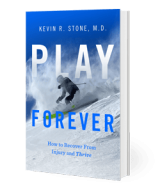The Lessons of Tiger Woods
Superstars crash. This happens commonly enough, in fact, that we hear only about the ones who do so spectacularly—like Tiger Woods. Between 1997 and 2011, Woods broke nearly every golf record, until his life unraveled with divorce, personal injury, and self-destructive behavior. Without any inside knowledge of his particular issues during this low point in his life, here are a few lessons I believe we can all take away from his story.

This article is adapted from Dr. Stone's book Play Forever.
Natural golf swings are just that: natural. For youthful athletes with phenomenal skills, coaching should focus on preserving those skills and focusing the mind to avoid the distractions that destroy them. After his dad, Tiger had one other great early coach who guided him through his entry into professional golf. Ditching that coach, and repetitively reinventing his swing, led to a series of failed efforts to get “better.” That’s partially because he was already the best. The enemy of the good is perfect, but the enemy of the best is a fanatical competitive drive that lives within many top athletes.
Bulking up is good for weightlifting, but not for a golfer’s rhythm. Tiger led the way out of the fat, out-of-shape, sloppy golf land of mixed plaids and baggy pants. He also brought a new level of fitness to a game that had little perception of the need for muscles to create power. But he went too far astray when he bulked up—possibly with the help of anabolic steroids and weightlifting coaches. Tiger’s physique changed as clearly as Barry Bonds’ changed, from lean to huge. He excelled in power but lost the grace we so admired. Whether or not his later injuries were a result of that transformation, no one knows; but we can’t help but wonder. If only Tiger had stayed lean, and just powerful enough to swing the club with the beauty of the youthful god of golf that he was.
Tigers’ back surgeries, which began in March of 2014, didn’t help either. That’s because back surgery often doesn’t work for athletes. Yes, many successful back operations relieve pain and provide stability to millions of people. Yet very, very few athletes return to sports that require high-torque, powerful twisting motions and the ballistic striking of balls, racquets, people, or other objects.
Once the anatomy of the back is changed by injury or surgery, healing is rarely completely normal. While surgery may fix one level of the spine—as when a fusion is performed—the levels above and below absorb more force and degenerate. If tissue is taken out, the target vertebrae often collapse. Because of this, new anabolic therapies using injections of growth factors and stem cells are exploding in popularity. The future is hopeful—but for Tiger, his career took a dive once the back-surgery cycle started.
The mind controls the game. Happy people have happy careers. If their personal lives fall apart due to divorce, drugs, or alcohol, few top athletes stay on top of their game. When you see the first public displays of personal dysfunction—such as the crashed car on the house lawn after a marital conflict—both the support team around the athlete and the public need to come together to assist in the rehabilitation of the athlete’s personal life.
When personal lives come tumbling down, athletic careers often follow suit. The personal stability that brought the athlete to the pinnacle of success is usually what keeps them there. Losing that support, often by looking for greener pastures, is likely to cause so much mental turmoil that the athlete’s professional performance is at risk. If athletes were stocks, they would be shorted upon the first disclosure of such difficulties. Tiger failed to correct, to reconcile, and to use his counselors to rebuild trust and relationships. His golden future seemed doomed.
Yet not all collapses are permanent. Tiger made a comeback. As he played his way to winning the 2019 Masters Tournament at Augusta National Golf Club, commentators frequently mentioned his poise and determination. He was playing with the brain of a thoughtful, strategic golfer. He had the “look” of a winner, and a “stare” on the 12th hole that left his competitors no doubt that they were witnessing the comeback of a champion.
It is easy to point out life’s lessons in retrospect. We are surrounded by thousands of examples of downfalls, displayed in every supermarket tabloid. Still, we continue to cheer our failing superstars on, hoping they have some mental superpower that helps them defy the odds. We all know why we do this. We are hoping that if and when that time comes for us, we will have that superpower as well.
You may find more guidance on mental and physical sports performance in Dr. Stone’s new book Play Forever: How to Recover from Injury and Thrive, on Amazon now.

